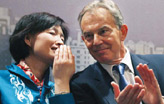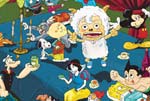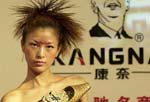Acrobatics needs to jump outside the box
Updated: 2011-04-01 10:22
By Chen Yuan (China Daily European Weekly)
China is an acrobatic superpower and its acrobats have won several laurels for their performances in the international market.
In spite of all the bouquets, the industry has not made rapid strides and faces several problems such as lack of innovation, weak competitiveness and insufficient backup systems.
The insipid progress is surprising considering that acrobatics was one of the first art disciplines to gain international recognition and spread wings overseas.
Despite the progress, Chinese acrobatics is still struggling to develop markets and come up with new acts. It is also surprising that China's market share in the acrobatics market is not commensurate with its reputation.
Several disadvantages exist for the acrobatics sector in China, says Cai Wu, the minister for culture.
Chinese acrobatics is short of innovation and full of homogenized performances. The international competitiveness is lacking in Chinese acrobatics and there are hardly any strong or competitive brands. Intense competition among the low-end international performance teams is also stifling the sector.
There is also a lack of balance between the various disciplines. While magic tricks are gaining popularity due to television programs, other sectors such as circus, illusion and humor are still in a quagmire due to shortage of staff and paucity of ideas.
There is also a shortage of stages for performances. Enough care has also not been paid for the social welfare of the performers.
China is good at acrobatics skills with many unique performing techniques. But with the introduction of new technology in acrobatics, the traditional Chinese acrobatics is fast losing its competitive strength.
Yu Yigang, head of Shanghai Acrobatic Group, says that Chinese acrobatics performances are lagging international standards. Chinese performers are only able to create "small productions" with their own scripts, whereas big international brands such as the Canadian Sun Circus are able to integrate lots of programs into one single stage performance, backed by modern technology and strong marketing.
Many people describe Chinese acrobatics as "only claps but no laughter". Ning Genfu, vice-chairman of China Acrobats Association, says that most of the performances nowadays are technique-oriented. The absence of humor extends to most of the national acrobatics competitions.
Clowns - the core character of acrobatic performances - often have the pride of place in international shows. "Clowns are the soul of acrobatics and the creators of humor" and as such "should be the thread of the acrobatics performances", says Ning.
The top prize at the International du Cirque de Monte-Carlo, the highest competition for circus performers around the world, is aptly named "golden clown".
There have also been heated discussions on the lack of star power in acrobatics. Many believe that acrobatics is a group art, whereas others argue that stars are essential for the art's existence.
Some experts have argued that the most wanted stars in acrobatics are clowns. Two famous German clowns recently started the world's only "clown school" and have managed to draw in students from over 50 countries.
Chinese acrobatic groups often have two roles. They are an art school and a performance group. This mode doesn't cater to the healthy development of the industry, as it requires specialization and delegation of work.
Bian Faji, chairman of Chinese Acrobats Association, says that China needs to establish higher education centers to sharpen the skills of the acrobats. Performance theory, foreign languages, modern business skills and general knowledge should all be incorporated into the acrobatic curriculum. Efforts should also be made to set up more acrobatics performance stadiums in cities to maintain China's edge over other nations in acrobatics.
Yu says that acrobatics also needs innovation. Chinese mentality should be changed and breakthroughs should be made in its mechanism.
New management ideas are needed to guide the art production to make the transition from the traditional "one trick goes anywhere" to "creativity leads", and "production in accordance with sales".
We should also divide the audiences into different categories and create art pieces catering to different tastes. Acrobatic techniques should be employed in all kinds of performances with different cultural connotation.
Compared to other arts, Chinese acrobatics has enjoyed good reputation abroad. But China has placed too much emphasis on international competitions and neglected to market these performances.
Many actors work for foreign brands, while most of the acrobatic programs end up as part of big-ticket events. Zhao Ming, director of the acrobatic program Swan Lake, says that Chinese acrobats will need to think out of the box to garner more market share.
They also need to tailor their performances to various markets and evolve proper marketing and management techniques.
The author is a journalist with the People's Daily.
E-paper

Green mission
Tony blair believes China will take a leading role to fight climate change and cut emissions.
The spring of new professions
Real modern times
F1 sponsors expect returns from Shanghai stop
Specials

Share your China stories!
Foreign readers are invited to share your China stories.

Have you any wool?
The new stars of Chinese animation are edging out old childhood icons like Mickey Mouse and Hello Kitty.

Fill dad's shoes
Daughter and son are beginning to take over the family business of making shoes.
